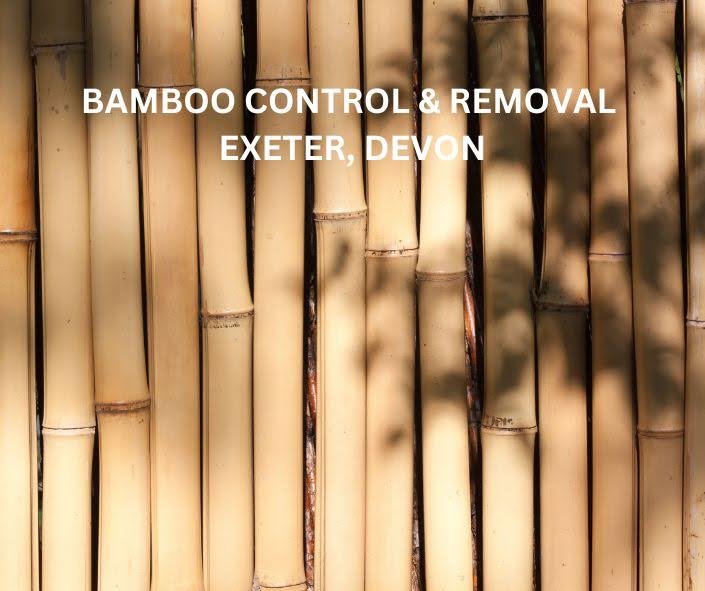Bamboo, often associated with serene Asian landscapes and charming garden designs, can become a persistent problem when it invades unintended spaces. Our Exeter Tree Services team knows that the rapid spread of bamboo has raised concerns among homeowners and environmentalists alike. While bamboo can add an exotic touch to gardens, its aggressive growth patterns can lead to significant challenges. Understanding the nature of bamboo encroachment and learning effective remediation techniques is crucial for maintaining property value and environmental health.

The problem of bamboo encroachment is not just limited to aesthetic issues. Its robust root system, known as rhizomes, can spread underground, often unseen, until it emerges in unexpected places.
This can cause damage to driveways, patios, and even building foundations. Moreover, bamboo can outcompete native plants, leading to a decline in local biodiversity. Addressing these issues promptly and effectively is essential for any property owner dealing with this invasive plant.
Understanding Bamboo Encroachment
Bamboo encroachment occurs when bamboo spreads beyond its intended area, typically through underground rhizomes that extend and sprout new shoots far from the original planting site. In Exeter, several types of bamboo, particularly running bamboo species, are notorious for their invasive nature. These species can grow rapidly, often up to several feet per year, making containment a significant challenge.
The rapid spread of bamboo poses several problems. Environmentally, bamboo can outcompete native vegetation, reducing biodiversity and altering local ecosystems. For property owners, bamboo can cause structural damage. The roots can infiltrate cracks in driveways, patios, and foundations, causing significant and costly damage over time. Additionally, bamboo can create legal issues if it spreads onto neighboring properties, leading to disputes and potential legal action.
Signs of bamboo encroachment include the appearance of bamboo shoots in unintended areas, dense thickets that are difficult to control, and visible root systems spreading across the property. Homeowners should regularly inspect their properties for these signs, particularly if they live near areas where bamboo is prevalent. Early detection is key to preventing extensive damage and ensuring that remediation efforts are effective.
Methods for Bamboo Control and Removal
Controlling and removing bamboo can be a daunting task, but with the right approach, it is manageable. Non-chemical methods are often preferred due to their environmental benefits. Manual removal involves digging up the bamboo clumps and rhizomes, which can be labor-intensive but effective if done thoroughly. It’s essential to remove as much of the root system as possible to prevent regrowth. Installing physical barriers, such as deep root barriers made of metal or plastic, can also help contain the spread. These barriers should be installed at least two feet deep to block the rhizomes from spreading.

For those who prefer a chemical approach, certain herbicides can be effective against bamboo. Glyphosate-based herbicides, when applied correctly, can kill bamboo, but multiple applications are often necessary due to bamboo’s resilience.
It’s important to follow all safety guidelines when using herbicides to minimize environmental impact and protect personal health. Combining chemical treatments with manual removal can increase the chances of successfully eradicating bamboo.
Deciding between manual and chemical methods often depends on the extent of the bamboo infestation and the homeowner’s preferences. For small patches, manual removal might be sufficient, while larger infestations may require a combination of methods. Regular maintenance and monitoring are crucial, as bamboo can be persistent and may require ongoing efforts to keep it under control.
Professional Bamboo Removal Services in Exeter
In some cases, the extent of bamboo encroachment may be beyond what a homeowner can handle alone. Professional removal services offer expertise and equipment that can make the process more efficient and effective. Signs that it’s time to call a professional include widespread bamboo growth that manual efforts have not controlled, bamboo causing structural damage, and legal issues arising from bamboo spreading to neighboring properties.
Professional bamboo removal services in Exeter are equipped to handle large-scale infestations. They use specialized equipment to dig deep and remove as much of the root system as possible. These professionals also have access to more potent herbicides and know how to apply them safely and effectively. Hiring a professional can save homeowners time and effort and provide peace of mind knowing that the job is done correctly.
When selecting a bamboo removal service, homeowners should look for reputable companies with experience in dealing with bamboo. It’s important to ask about their methods, the expected duration of the project, and any guarantees they offer. Checking reviews and asking for references can also help ensure that the chosen service provider is reliable. By carefully selecting a professional service, homeowners can ensure effective bamboo removal and prevent future encroachment.
Preventing Future Bamboo Encroachment
Once bamboo has been removed, it’s crucial to take steps to prevent it from returning. Regular maintenance, including inspecting the property for new shoots and removing them promptly, is essential. Landscaping techniques, such as planting bamboo in containers or using root barriers, can help contain its growth. Homeowners should also be cautious about introducing new bamboo plants to their property and consider alternative plants that are less invasive.
Understanding local regulations regarding bamboo planting and maintenance can also help prevent future issues. In some areas, there may be restrictions on planting certain types of bamboo due to their invasive nature. Homeowners should familiarize themselves with these regulations and ensure that they comply. Additionally, joining local community groups focused on gardening and invasive species can provide valuable support and resources.
Preventing bamboo encroachment requires a proactive approach and ongoing vigilance. By implementing best practices and staying informed about local regulations, homeowners can enjoy the benefits of bamboo without the associated problems. Regular maintenance and prompt action at the first sign of new growth are key to keeping bamboo under control.
Find Bamboo Removal Specialist Near Me – Exeter
Bamboo encroachment is a significant issue in Exeter, Devon, that can cause environmental and structural problems if left unaddressed. Understanding the nature of bamboo and its invasive tendencies is the first step in managing this issue. Homeowners have several options for controlling and removing bamboo, including manual and chemical methods. In cases of extensive infestation, professional removal services can provide effective solutions.
Preventing future bamboo encroachment requires ongoing effort and vigilance. By implementing preventative measures and staying informed about local regulations, homeowners can keep their properties bamboo-free. Taking action early and consistently is essential for managing bamboo and protecting property and environmental health. Sharing experiences and tips with others can also help build a community of informed and proactive homeowners ready to tackle bamboo encroachment effectively.
Exeter, Devon Tree Surgeon FAQ
How much does it cost to remove bamboo in the UK?
The cost of bamboo removal in the UK varies significantly depending on several factors, including the type of bamboo, the extent of the infestation, and the location. Keep in mind that some bamboo removal specialists in Exeter may price based on a cost per square foot/cost per square metre basis.
For larger projects, particularly those involving running bamboo, costs can rise due to the need for specialised equipment and more extensive labor. Running bamboo, which has a more aggressive root system, typically costs more to remove than clumping bamboo. For substantial removal jobs involving heavy machinery and complex access issues, you’ll need to consult with a professional.
In cases where bamboo has caused significant structural damage or has spread extensively, the cost factor can be much higher as the structural issues will also need to be addressed. Factors such as the need for stump grinders, the accessibility of the affected area, and additional labor for excavation can all contribute to the higher end of the price spectrum.
Hiring a professional is often advisable to ensure thorough and effective removal, especially for large infestations. Professionals have the necessary tools and expertise to handle both the removal and disposal of bamboo, which helps prevent regrowth and environmental issues. Homeowners in London and the South of England may face higher costs due to increased labor rates in these areas.
How do you get rid of invasive bamboo?
To get rid of invasive bamboo, start by cutting the bamboo stems to ground level and then dig out the root system, or rhizomes, which spread underground. Installing physical barriers at least two feet deep can help prevent regrowth. For persistent bamboo, applying a glyphosate-based herbicide can be effective, but multiple treatments may be necessary. Consulting with a professional removal service can ensure thorough eradication, especially for extensive infestations.
How to remove bamboo roots in the UK?
To remove bamboo roots in the UK, start by cutting the bamboo stalks down to ground level. Next, dig out the rhizomes, which are the underground stems that spread horizontally. Be thorough in removing all pieces of the rhizomes, as even small fragments can lead to regrowth. For persistent roots, you may need to apply a glyphosate-based herbicide and repeat the process multiple times. Hiring a professional can ensure a comprehensive removal, particularly for extensive infestations.
What is the best tool to remove bamboo roots?
The best tool to remove bamboo roots is a combination of a sharp spade or shovel and a mattock for digging and cutting through the dense rhizomes. A garden fork can also be useful for loosening the soil around the roots. For larger or more stubborn root systems, a heavy-duty tool like a root barrier or even a stump grinder might be necessary.
What is the cheapest way to get rid of bamboo?
The cheapest way to get rid of bamboo is to manually cut the stalks down and dig out the roots using a spade or shovel. This labor-intensive method requires no professional help or expensive equipment, but it does take time and effort. Installing a simple root barrier can also prevent regrowth without the need for chemical treatments. While manual removal may be the most cost-effective, it’s important to monitor the area regularly for new shoots and remove them immediately to prevent the bamboo from returning.
